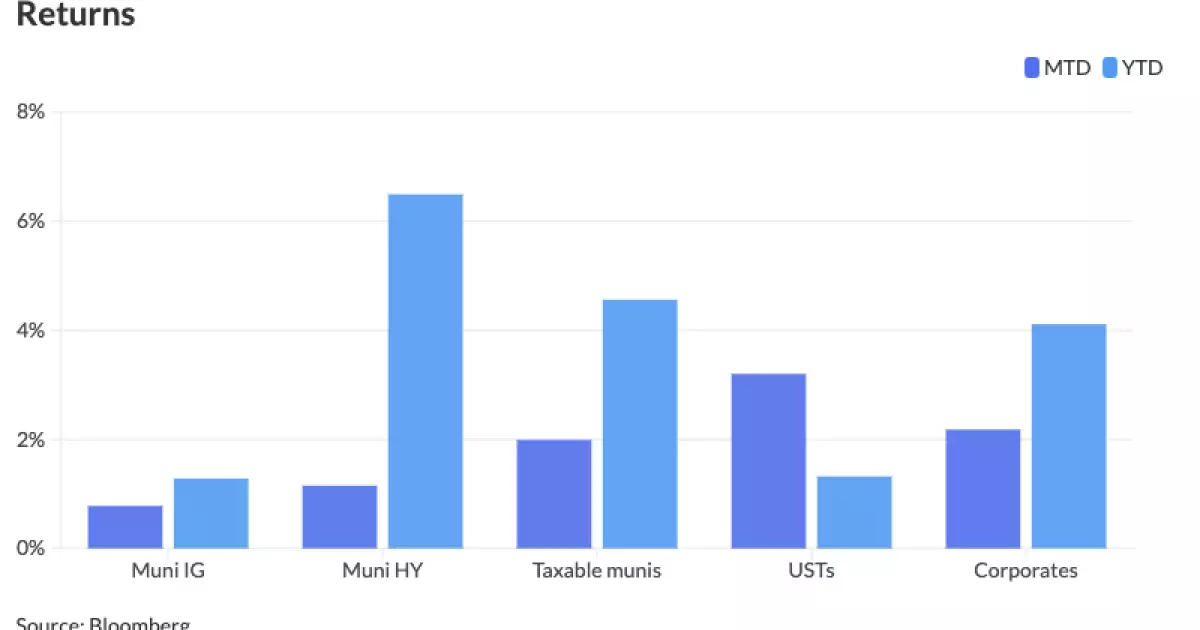The municipal bond market exhibited stability on Monday, opposing slight weakness in U.S. Treasuries and a mixed outcome in equities. The ratios of municipal bonds to Treasuries reflected a relatively stable environment, with notable figures including a 62% ratio for two-year munis and an 87% ratio for 30-year munis, according to data from Refinitiv Municipal Market Data. These ratios indicate a sustained interest in municipal bonds as investors seek preservation of capital amidst fluctuating Treasury yields and stock market volatility.
The details paint an encouraging picture for the municipal bond sector, contrasting sharply with the losses experienced in the same month last year. In August 2022, municipal bond investors faced a decline of 1.79% as the Federal Reserve remained entrenched in a rate hike strategy aimed at combating rising inflation. Fast forward to August 2023, the landscape is markedly different. This month, municipal bonds have yielded a gain of 0.78%, bringing year-to-date returns to a respectable 1.28%. The improving sentiment reflects a shifting macroeconomic backdrop as the Federal Reserve hints at loosening its monetary policy.
Interest rates across the municipal yield curve have been a focal point for market participants. As reported, yields saw a rise of approximately 26 basis points on average throughout August, particularly emphasizing the 10-year notes, which surged around 36 basis points. Yet, in a month-to-date assessment, 10-year municipal yields fell by an average of 2.5 basis points. This dynamic suggests a cautious optimism from investors as the markets realign following Federal Reserve Chairman Jerome Powell’s recent comments indicating a potential shift towards rate cuts.
Powell’s statements have prompted a ripple effect in the bond markets, illustrating how Federal Reserve policy directly influences market sentiment and, consequently, yields. The notion of lower rates ahead has spurred a reaction in Treasury yields, which have already started to decline, thereby encouraging investors’ appetite for munis.
The summer months typically bring a slowdown in municipal bond trading activity, exacerbated this year by holiday absences and market participants’ reduced engagement. As Chris Brigati from SWBC noted, the market’s reaction to U.S. Treasury movements was limited last week, with the exception of the short end of the muni curve, which responded to Powell’s speech. This subdued activity emphasizes the prevailing cautious nature of investors in a time marked by potential volatility.
However, as the summer break wanes, analysts have observed a gradual uplift in interest in the secondary market, especially for longer-term bonds. Muni-to-U.S. Treasury ratios recently approached 90% for the 30-year category, underscoring the attractiveness of longer-dated munis as viable investment options amid tepid economic signals.
Looking ahead, the supply of municipal bonds is set to remain relatively steady despite minor drops due to the approaching Labor Day holiday. This week, the market expects around $8.9 billion in new issuance. Notable upcoming deals include the North Texas Tollway Authority’s $1.1 billion refunding bonds and New York City’s Transitional Finance Authority’s $1.8 billion offerings.
These upcoming issuances could provide valuable opportunities for investors, particularly amid expectations of increased issuance in subsequent weeks. Market strategists emphasize the likelihood of above-average issuance, which could help absorb the reinvestment cash anticipated to decline in the near term.
The municipal bond market remains in a steady position as it adapts to a shifting economic environment. Observations suggesting a retraction in yields amid Federal Reserve policy adjustments combine with a slightly more active primary market herald optimism for investors looking to engage in municipal securities. Caution is still warranted as the markets remain sensitive to broader economic indicators, but the prevailing sentiment supports an outlook that combines both stability and potential for upside.
The landscape of municipal bonds is flourishing, bridging the gap between investor expectations and market realities, thus positioning them as a strategically prudent choice for a diverse investment portfolio in these uncertain times.

